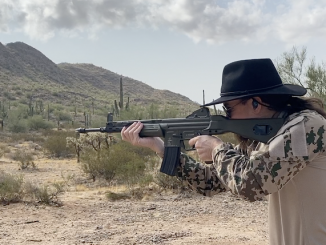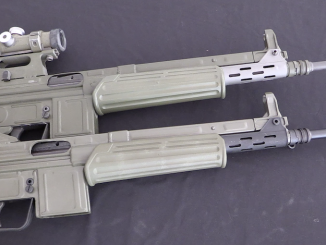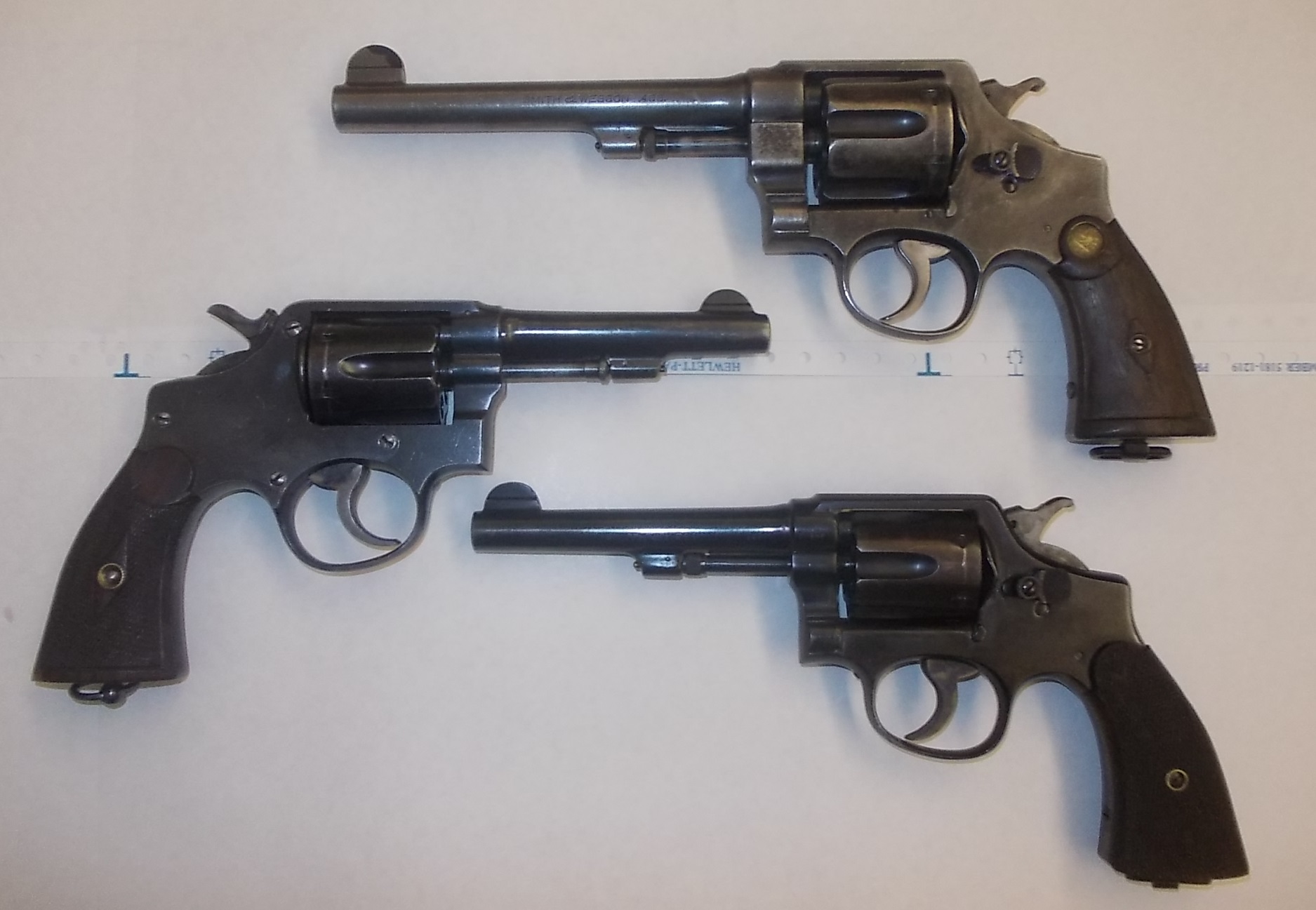The FR-8 is a Spanish rifle manufactured in the 1950s as part of Spain’s adoption of the CETME semiautomatic rifles. Spain was not only moving to their first semiauto rifle, but also changing from 8mm Mauser to the new 7.62mm NATO. It was not possible to immediately equip everybody with the new rifles, so a parallel program was instituted to modify the now-obsolescent bolt action rifle in inventory into a more useful configuration.
FR-8 was the designation for an M43 Mauser (of the model 98 pattern) rebuilt as a training and second-line rifle. The original barrel was replaced with a 7.62mm barrel , along with a front sight duplicating that of the CETME. Where the CETME had a charging handle tube above the barrel, the FR-8 had a similar hollow tube below the barrel, which was used for storing a cleaning kit. The rear sight was similarly modified to duplicate the CETME sight picture and range adjustments. A muzzle brake was fitted so that standard 22mm NATO grenades could be launched (a further benefit for training compatibility).
Contrary to popular misconception, the FR-8 was designed to be used with normal full-power 7.62 NATO ammunition, not a reduced-charge specialty round.




I bought one of these years back. It was a very compact fast handling little gun. The problem with it was that it shot a foot high at 100 yards. Adjusting the sights had no real effect and I couldn’t match bullet placement. Had a metal butt plate and kicked like a mule too as it was a fairly light rifle. Cool looking guns though. If you get an accurate one it would make a great truck gun.
There was also a FR-7 “Cetmeton” (CETME + MosqueTON), that was built parallely from even older 7mm Mosqueton Oviedo Mod. 1916 (short rifle derived from Mauser type 1893). These rifles suffered basically the same transformation to become FR7 than M43s to FR8, so they share the same barrel and caliber (7,62 NATO) that FR8s but have a different action (bent handle and M1893’s cock-on close) and a different stock (no semi-pistol grip, straight instead).
I have a fr7. Haven’t shot it much.
I check your interesting site each morning with my coffee cup in hand. Your information is very educational and it puts a unique twist to the World of firearms. Thank you for same, I’m sure I speak for many of your followers.
I own both the FR-7 and FR-8 and have had a lot of fun. The Serial number on my FR-7 is 002XX and the lowest serial # I have seen is 00157 which I do not own. These rifles have a loud report due to there short stature. However they are fun to shoot and I enjoy mine.
Ian, I don’t believe I have ever heard that the FR-8 could not handle full power 7.62 NATO loadings as the m98 (M43) standard chamberings equaled the 7.62 NATO loadings. Now the FR-7 is an entirely different matter. The FR-7 is based on the Model 1916 short rifle, which in turn was based on the Mauser Model 1893 which is not designed for those pressures.
IIRC the 1952 date on the receiver was the date of manufacture of the rifle in its original 7.92 cal.
Considering that the Mauser action was already overkill for the original 8×57 IS, it makes sense that one would want such a system when shooting 7.62 NATO. And of course this rifle should not be chambered for “weak gallery ammunition” (that description would be for “youth scale” rifles chambered in .22 LR)… I would still not like to look down the business end of this weapon, training weapon or not!
I remember when these were kinda common back in the 90’s on the surplus firearms market. A bolt gun with a modern twist in a modern military chambering ,what’s not to like. Heard that the recoil was pretty stiff and not too much fun to shoot from the bench. I’ve also talked to people who owned them that they seem to shoot high also.
Interesting to compare to the Ruger Gunsite Scout.
Wouldn’t mind having one now. Never got one back then as the cautionary warnings were quite specific. They boiled down to nearly a single word… Well okay, a single word plus… 7.62 NATO, NO!!!
Honestly, even then, I can recall that It didn’t think it made sense. Why go to all the trouble to make a substandard item when even a small increase of effort would result in a viable and worthy full powered arm?
Nice to know that wasn’t true, but in those halcyon past days of yore, who knew? Or for that matter, who wanted to take the chance of a permanent one-eyed pirate look?
The thing to know, however, is, every now and again, somebody shows up at the range with a full charge, short barreled carbine. I have personally witnessed it several times, and usually the shooter is asked to leave by the rangemaster. Why? Because the report is not only so egregiously loud but the muzzle-flash is bigger than your head..
Clue? When the person at the next shooting point puts on a motorcycle helmet, it’s time to call the range master.
No excuses valid for a .500 Magnum out of a 10 inch barrel.
If the person next to you can’t stand the report or gets scared of muzzle flash it’s time for them to take up the hobbie of shooting air soft guns. Sorry if you can’t stand the heat stay out of the kitchen.
I have never seen in person much less fired a Cetmeton but I have a Ruger GSS which has a 16.1″ barrel in .308 Winchester and I can tell you that the report and muzzle flash (it does have a flash suppressor) are quite tolerable, although obviously more than you’d get from a lesser cartridge.
Matisse,
What was most likely being referred to was the FR7 the one based off of the M93 Mauser design. The max cartridge pressures the M93 is designed around to handle repeatedly is the 7MM Mauser and it does that quite well. The 7mm Mauser develops 51,000 psi or 46,000 CUP, the .308 Win Service Pressure Max – 62k PSI, 7.62×51 NATO Service Pressure Max – 50k CUP, or 60/61k PSI. Most designers of military firearms use a 20% overbuild as a design criteria because that once a military cartridge comes out seldom if ever does the max chamber pressure change. Based on that design criteria the design to pressure spec for the M93 Mauser design is 51,000 x .2 or 10,200 + 51,000 = 61,200. Constant operation at or exceeding the upward limit of a design criteria is a recipe for disaster, for the M93 Mauser design and 7.62 NATO it generally means that due to failure of the receiver metal elasticity (no rebound) the locking lugs in the receiver will deform and bolt will slowly become harder and harder to unlock as it is set back into the receiver lugs and the rifle brass flows to fill the gap eventually locking the bolt into the receiver. I have never seen a chamber casting of one of these with a locked up bolt BUT I would expect to see an oversized chamber diameter as well.
Oh, Mik, buddy, it’s a sure sign of the inexperienced and the clueless as willing to subject others to rude behavior.
Especially on a shooting range.
Duh.
I understand the point of not shooting high powered rifles at the rim fire or pistol bay, but if it is ok for high powered rifles at the particular bay your shooting at I think its fair game to blast away with your fire breathing carbine as long as it doesn’t violate any of the range rules. Not trying to be rude. Everyone needs a place to shoot, even owners of short barreled carbines .
It should be noted that the date on the receiver is the date of manufacture as an M-43. I’ve seen receivers marked with every year from 1945-1958 (M-43s can go as early as 1943, and Spanish Navy rifles were made into the 1960s, including in 7.62 NATO rather than 7.92). These were not converted in the early 1950s, nor was the 7.62 NATO cartridge adopted early (the Spanish through most of the 1950s were working on the 7.62 CETME cartridge for use in early CETME designs). These conversions were done after the adoption of the CETME Model C, starting in the very early 1960s.
No all were converted from M-43s, either. The M-44 was also used at times (with Air Force markings removed), as were Gewehr 98Ms (I’ve seen several manufacturers represented, such as Spandau) and Polish rifles, among other large-ring Mauser 98 actions in inventory, as well as undated Civil Guard marked M-43s. Stocks were replaced by the modified M-43 stocks. Original markings on all receivers regardless of origin were scrubbed except, in most cases, those on top of the receiver ring. Serial numbers were scrubbed from all other parts that had them and which were retained.
Regarding the stocks, the rear swivel attachments have nothing to do with the conversion. They are original M-43 components. The M-43 was indeed intended for both foot and mounted use. The forward attachment is, of course, a CETME type. The CETME sling was intended to be side-mounted to these rifles, as it is on the CETME.
As far as the FR-7 goes, it was intended to use the 7.62 NATO cartridge despite not being a 98 action. Whether or not this is a sound practice has been the subject of much debate, but in service those rifles, and the other M1916 conversions, used the 7.62 NATO cartridge. The CETME round could be used if that’s what was available, and the manuals provided the ballistics for it for use in the FR-7 and FR-8. It should be noted that the internal ballistic data shows pressures similar to those of the NATO cartridge, the result of using a different powder that burns in a rather different manner than that used by Santa Barbara in the NATO cartridge, so reduced pressure would not be a justification for use in the FR- or M-1916 conversions.
Lots of misinformation. The author is absolutely correct in that the FR8 is designed for 7.62mm NATO.
7.62mm NATO is the same as .308 Winchester. There are slight variations due manufacturing tolerance. The only issue with military rifles is fact most have a slightly oversized chamber. If a field headspace gauge works it is safe to fire .308 Winchester out of a 7.62mm bolt gun without damage.
The FR-7s and FR-8s are the only military M98 Mausers I’m aware of that were ever issued with peep sights. As others have stated, the FR-7’s M93 action is weaker than the FR-8’s M98 action, though not drastically so. M98 actions have been the basis for countless custom, magnum rifles, so any concerns about the FR-8 handling 7.62 NATO or .308 Win. is just so much piffle.
Also, the wive’s tale about “soft Spanish steel” needs to finally be put to rest. When the Spanish M43 rifles were manufactured, Spain was not at war and high quality materials and manufacturing techniques were used. Meanwhile, most German M98s were manufactured under a wartime economy, in many different factories – including some in occupied countries – and in certain cases, using slave labor. In spite of this, too many people automatically assume that German M98s are superior and relegate Spanish M98s to the suspect category. This is entirely incorrect and while German QA was generally good, there is no objective data to indicate that they were “better” than their Spanish-manufactured counterparts.
Best regards
Doc
HI
I have two of the Spanish sniper rifles. The M43 with the late 10x 32 Japanese made scope, Marine 10×32 and the Japanese made by Eikow in 10×32 And FR 8 sniper rifle I would like to talk to anyone about the two Spanish sniper rifles there is not know about them . Regards Robert Hickey